AMD Radeon RX 5500 XT review: Bleeding-edge on a budget - brownforall
At a Glance
Practiced's Rating
Pros
- Good 1080p gaming performance
- Fast GDDR6 VRAM, PCIe 4.0 support
- Great mogul efficiency
- Bundled with Teras Hunter World: Iceborne Edition and 3 months of Xbox Game hand down
- Sapphire's cooler is whisper quiet and very cool
- Sapphire Pulse has great features for the price
- Trixx Boost software uses smart downscaling for FPS gains
Cons
- Doesn't outperform RX 580 or GTX 1650 Super in many games
- Costs more than GTX 1650 Super and 8GB RX 580
- Any cutting-boundary Navi features aren't beneficial in budget GPUs
Our Finding of fact
AMD's Radeon RX 5500 XT brings its next-gen navi GPU architecture to the masses, with mixed results. It's a good budget gaming option that's priced slightly too high.
Best Prices Today

$179.99
When it comes to graphics cards, AMD's closely-held the Cuban sandwich-$200 Mary Leontyne Pric point for years. Nvidia's GeForce GTX 1060 and 1660 series graphics cards couldn't hold a cd to the value suggestion of the Radeon RX 570 and 580, nor its predecessors, especially once AMD started bundling them with games galore. Those North Star-powered GPUs are downright ancient, however, and suck down obscene amounts of power compared to modern art cards.
Enter the new $169 Radeon RX 5500 XT, launching today aft being teased in October.
The Radeon RX 5500 XT brings AMD's "Navi" GPU, built using the keep company's adjacent-gen RDNA graphics architecture, to the masses. Navi debuted in the Radeon RX 5700 and 5700 XT, which immediately became our go-to recommendations for 1440p gambling. Navi's loaded with press clipping-boundary tech: The Radeon RX 5500 XT is one of the world-class consumer GPUs built using 7nm process technology, and to support the hemorrhage-march PCIe 4.0 interface. Information technology's upgraded to extremist-fast GDDR6 remembering. The card packs AMD's latest and greatest media encoders, and good reveal technologies that enable 4K, 144Hz monitors without the need for messy chroma subsampling (though you won't game at anywhere near those levels with this humble graphics bill of fare). It's enormously much mogul-efficient, too.
Nonetheless disdain all those advances, and all AMD's previous wins with Polaris and Navi, the Radeon RX 5500 XT can't lay claim to the mainstream crown. Nvidia's just-launched $160 GeForce GTX 1650 Super puts up a tough fight for the budget graphics card market. While AMD's card is alone $169, it's hush up priced excessively high for the public presentation IT delivers.
AMD Radeon RX 5500 XT specs, features, and price
As mentioned above, the Radeon RX 5500 XT uses a cut-down version of AMD's "Navi" GPU.
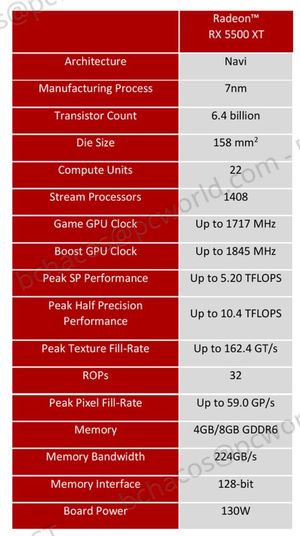 AMD
AMD Radeon RX 5500 Crosstalk specs.
Where the Radeon RX 5700 series packed 2,304 stream processors into the $350 Radeon RX 5700, and 2,560 SPs in the quicker $400 Radeon RX 5700 Crosstalk, AMD's mainstream-focused Radeon RX 5500 XT reduces that to 1,408 stream processors. The Radeon RX 5500 XT's effective clock speed during play splits the difference betwixt the cardinal RX 5700 cards, with a rated 1,717MHz Game Clock. A badger in AMD's new-sprung Radeon Software Adrenalin 2020 Edition prevented us from verifying that speed nether load, but should be fixed shortly after this calling card's launch, the company says.
Compared to the "Polaris" GPU-based graphics cards that the Radeon RX 5500 XT replaces, the shift to Navi is a proud deal, delivering each those fashionable new features as asymptomatic as vastly improved major power efficiency. But the change in memory helps reduce power necessarily, too. AMD's latest GPU packs ultra-fast, energy-efficient GDDR6 computer memory. Paired with a 128-bit bus, it's good for an general memory bandwidth of 224GBps. For comparison, the older Radeon RX 570 with GDDR5 memory hit the same speed but necessary a much wider 256-bit bus to come so, while Nvidia's $160 GeForce GTX 1650 Super achieves 192GBps with its 4GB of GDDR6 memory.
Both 4GB and 8GB models will be available starting at $169 and $199 respectively. AMD says that 4GB is the better price-to-performance option for most people, and it should deliver identical skeletal frame rates in many games—but not all. The AMD-supplied slide below shows the 8GB Radeon RX 5500 Crosstalk outpunching the 4GB model in some key games. We were sent a 4GB model for review.
 AMD
AMD Among all the various improvements, AMD claims that the Radeon RX 5500 XT delivers functioning to 1.6 times the performance-per-James Watt of the two-coevals-old Radeon RX 480, with 12 percent more inalienable carrying out at 30 percent inferior index draw. Effective carrying into action results vary game to bet on, as you'll see later o.
The Radeon RX 5500 Crosstalk requires 130W of power for the instrument panel, which means that all models will have to include at to the lowest degree a 6-pin power connector. The Sapphire Pulse Radeon RX 5500 XT we reviewed came accoutred with an 8-trap connector, along with an HDMI port and a trio of DisplayPorts.
 AMD
AMD This 1080p Navi GPU debuted in desktops and laptops alone, in the form of the Radeon RX 5500 and RX 5500M. The Radeon RX 5500 XT bound for DIY systems is basically a quicker version of the not-XT RX 5500, and unlike the Radeon RX 5700 series, it won't be available in a reference card version. The Radeon RX 5500 XT launches nowadays with a wide variety of custom models uncommitted from AMD partners like Lazuline, XFX, Asus, Gigabyte, and others. To sweeten the pot, AMD's agitated in a free copy of Monster Hunter World: Iceborne Master key Edition and iii gratuitous months of Microsoft's superb Xbox Game Pass for PC.
Next pageboy: Fitting the Sapphire Impulse Radeon RX 5500 XT
Meet the Sapphire Throb Radeon RX 5500 XT and Trixx Boost
We're reviewing the $180 4GB Sapphire Pulse Radeon RX 5500 XT nowadays. The Thomas More mainstream sibling to the enthusiast-class Nitro graphics cards, Sapphire's Pulse series delivers solid features and execution at an inexpensive price, charging a mere $10 premium over MSRP. We loved the Pulse iterations of the Radeon RX 570 and 580, as well as the Pulse Radeon RX 5700.
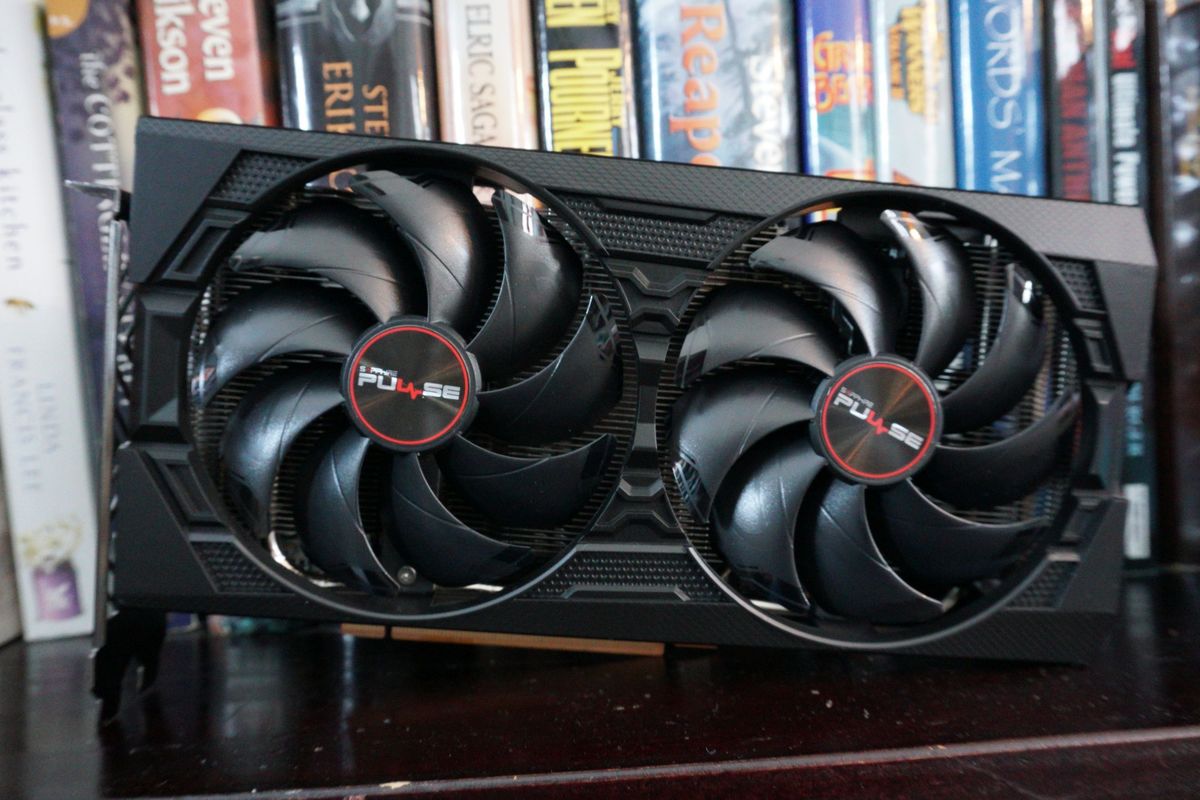 Brad Chacos/IDG
Brad Chacos/IDG The Sapphire Pulse Radeon RX 5500 XT continues the tradition and the same basic design. The card includes a pair of large fans atop a decently orange-sized heatsink, which help to keep temperatures low and sound minimal. It's even quieter on the desktop thanks to the much-receive comprehension of idle fan stoppage, which prevents the card's fans from spinning when the GPU isn't under encumbrance. Translation: The Pulsation Radeon RX 5500 XT is utterly silent during normal desktop usage. You can air sound levels plummeting symmetrical far by flipping a BIOS switch on the edge of the card over to a secondary Quiet profile.
Dual BIOSes and idle fan full point are rare features in tailored graphics cards that hover around MSRP, as is the sperm-filled-length metal backplate this card ships with. It's small-scale touches like these, at so much low-priced prices, that help Sapphire's Pulse serial publication stand out from the masses.
 Brad Chacos/IDG
Brad Chacos/IDG The argentiferous backplate and dual BIOS switching are rare niceties for graphics cards that stay close to MSRP.
The other thing? Software, at least directly that the Navi generation is here. Sapphire introduced the outstanding Trixx Boost feature to its Trixx software in the Pulse RX 5700, and it continues in fine manikin with the Pulse RX 5500 XT.
Check out the Trixx Boost division of our Pulse RX 5700 review for a fuller walk-through, but basically, Trixx Boost weaves together AMD's good Radeon Image Sharpening feature with slight resolution downscaling to give you more performance with tokenish visual compromises. You tell Trixx Boost how much you'd like to scale mastered the resolution, click Apply, and after a fewer screen flashes, you'll be able to take those new, armoured-down resolutions in games.
Trixx Encouragement defaults to 85-percent grading. That works wonderfully for the 1440p and 4K resolutions that the more powerful Radeon RX 5700 hangs around in, but we found it a bit too aggressive at the 1080p declaration that the Sapphire Pulse Radeon RX 5500 Crosstalk was built for. The 85 pct scaling created a new resolution of 1632×918; with far fewer pixels to form with than in the downscaling options for higher resolutions, it appeared just a routine too shimmery and pixelated to our eyes. Some games, like Strange Brigade, also resorted to framing the image in a letterbox at that resolution.
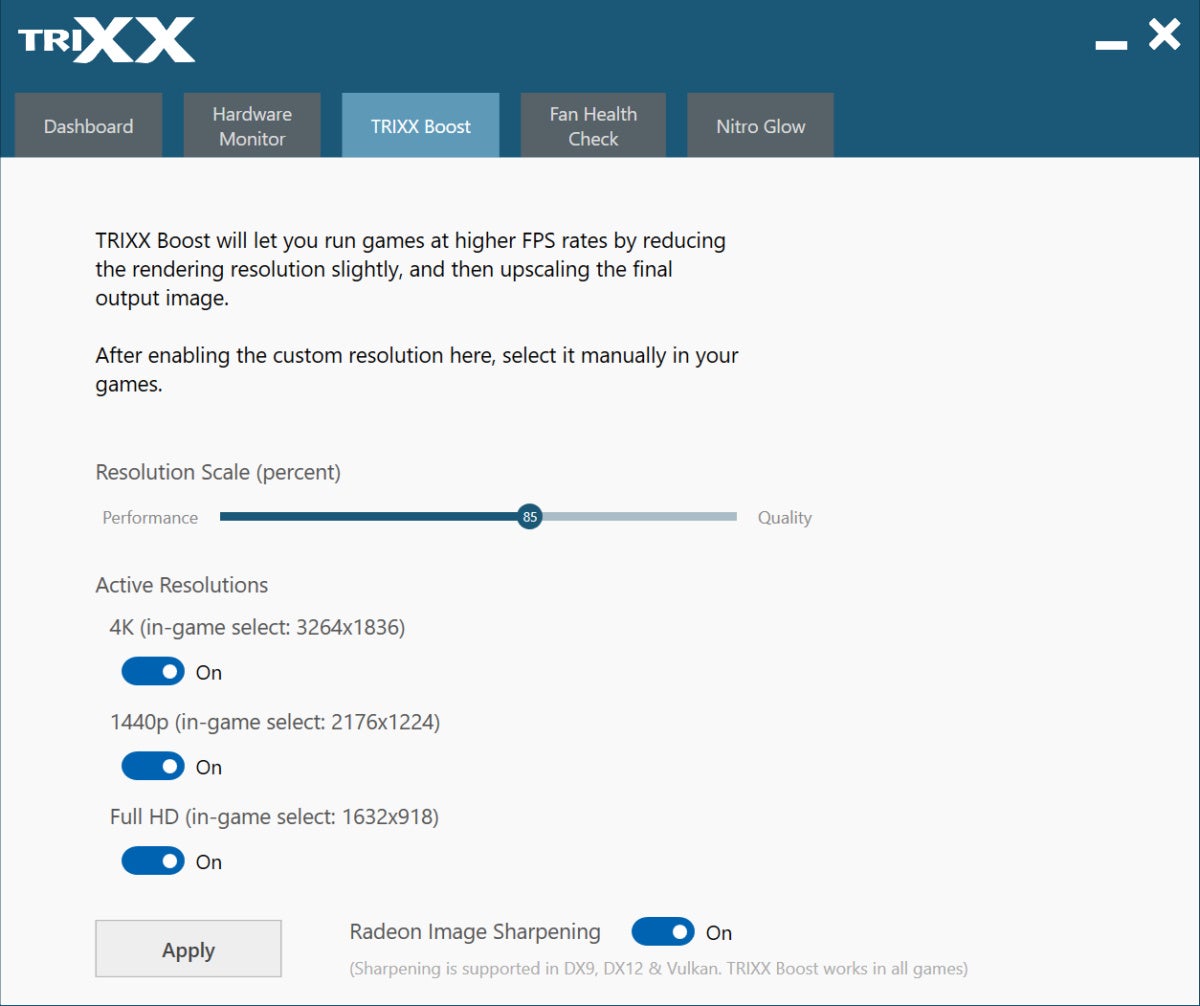 Brad Chacos/IDG
Brad Chacos/IDG Screenshot of an early epitome version of Sapphire's Trixx Boost functionality, captured with a Nitro+. The flow version also supports DX11 with Radeon Image Sharpening, which was added in the Radeon Software Adrenalin 2020 Edition update.
Bumping the scaling upwards to 90 percent—1728×972 resolving power—got free of those problems. Some pixelization can be seen if you really examine the image, but IT's barely palpable during actual gameplay. Of course, reducing the downscaling likewise reduces Trixx Boost's potential performance benefits, but as you'll see in our benchmarking session, IT can still deliver a meaningful difference depending on the game. We benchmarked all stake with the Pulse's out-of-the-boxwood performance every bit well as with Trixx Boost position to 90-pct grading.
Get into't blur Sky-blue's unrivaled Trixx Boost with AMD's new Radeon Boost feature. Trixx Boost is getable only for Sky-blue art cards, but IT works with any stake running any graphics API. Radeon Boost, introduced in the huge Radeon Software Epinephrin 2020 Version update just two days past, works with any modern Radeon graphics card, but only in a olive-sized handful of games, and only if those games are pouring in DirectX 11 mode. Radeon Boost dynamically downscales the game's resolution when you move your mouse operating room control stick in-brave to improve performance during action scenes.
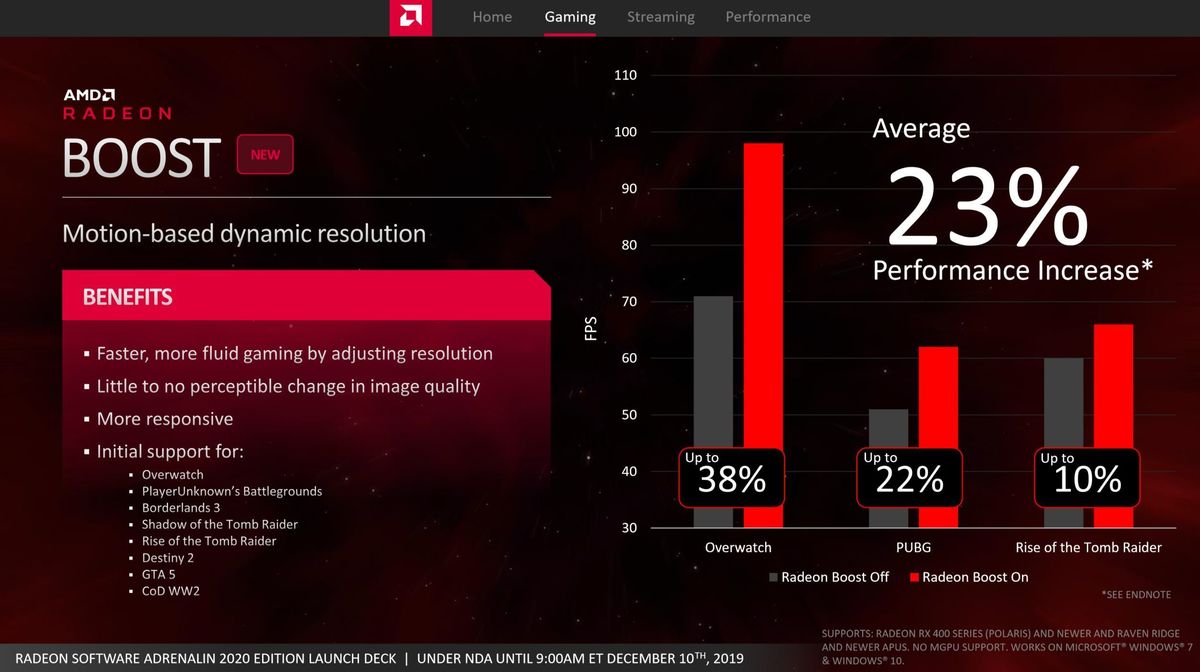 AMD
AMD AMD's own Radeon Advance provides selfsame different functionality than Sapphire's Trixx Boost, tying dynamic resolution scaling to your mouse movement in-game.
Trixx Boost provides its benefit practically much consistently. You could theoretically use both Boost technologies at the same time for even up faster performance, but given the express pixels available at 1080p resolution, combining downscaling tricks below that could get real grainy, real vivace. IT's worth a shot in Radeon Cost increase-mixable games that you want to try at 1440p resolution, though.
Next page: Our test system, performance benchmarks begin
Our test system
Our dedicated graphics card test organization is packed with close to of the fastest complementary components available to put any expected performance bottlenecks squarely on the GPU. Most of the hardware was provided by the manufacturers, simply we purchased the tank and storage ourselves.
- Intel Core i7-8700K CPU ($350 on Amazon)
- EVGA CLC 240 closed-closed circuit liquid cooler ($120 on Amazon)
- Asus Maximus X Hero motherboard ($395 on Amazon)
- 64GB HyperX Predator RGB DDR4/2933 ($420 on Amazon)
- EVGA 1200W SuperNova P2 power append ($230 happening Amazon)
- Barbary pirate Vitreous silica 570X RGB case, with front and tip panels removed and an extra rear lover installed for improved airflow ($130 on Amazon)
- 2x 500GB Samsung 860 EVO SSDs ($78 each on Amazon River)
We're comparison the $169 Chromatic Pulse Radeon RX 5500 XT against the identically priced 4GB Asus ROG Strix GeForce GTX 1650 Comprehensive, a kitted-out custom sit that charges a $10 bounty over the GTX 1650 Super's advisable pricing. We're also throwing in the 4GB Radeon RX 570, 8GB RX 580, and 8GB RX 590 graphics cards that the Radeon RX 5500 XT replaces, as well as the 6GB EVGA GeForce GTX 1660 XC Ultra to stage the GTX 1660 series, which now starts at $200. Be trustworthy to read our guide to the prizewinning graphics cards for PC gaming for a more holistic look at the GPU landscape.
Each game is tested exploitation its in-game benchmark at the highest possible graphics presets, with VSync, anatomy rate caps, and all GPU vender-specific technologies—like AMD TressFX, Nvidia GameWorks options, and FreeSync/G-Sync—disabled, and temporal anti-aliasing (TAA) enabled to push these card game to their limits. If anything differs from that, we'll citation it. We run each benchmark at least three multiplication and list the average result for each test.
We tested the Sapphire Radeon RX 5500 XT using its default Operation BIOS, sooner than its incidental Quiet BIOS that increases efficiency and lowers devotee speeds at the cost of performance. We're also including benchmarks for from each one game that show the results of using the Trixx Boost utility with resolution downscaling set to 90 percentage, as discussed in our introduction of the Pulse's unique features.
Gambling performance benchmarks
Division 2
The Division 2 is unrivalled of the best looter-shooters of all time created. The luscious visuals generated aside Ubisoft's Snowdrop engine make it even easier to get lost in post-apocalyptic Washington D.C. The built-in benchmark cycles through tetrad "zones" to quiz an array of environments. We test with the DirectX 12 renderer enabled; information technology provides better performance across-the-circuit card than the DX11 renderer, but requires Windows 10. (The Radeon RX 570 refused to complete a brimful bench mark run at 1440p resolution, crashing to the desktop repeatedly.)
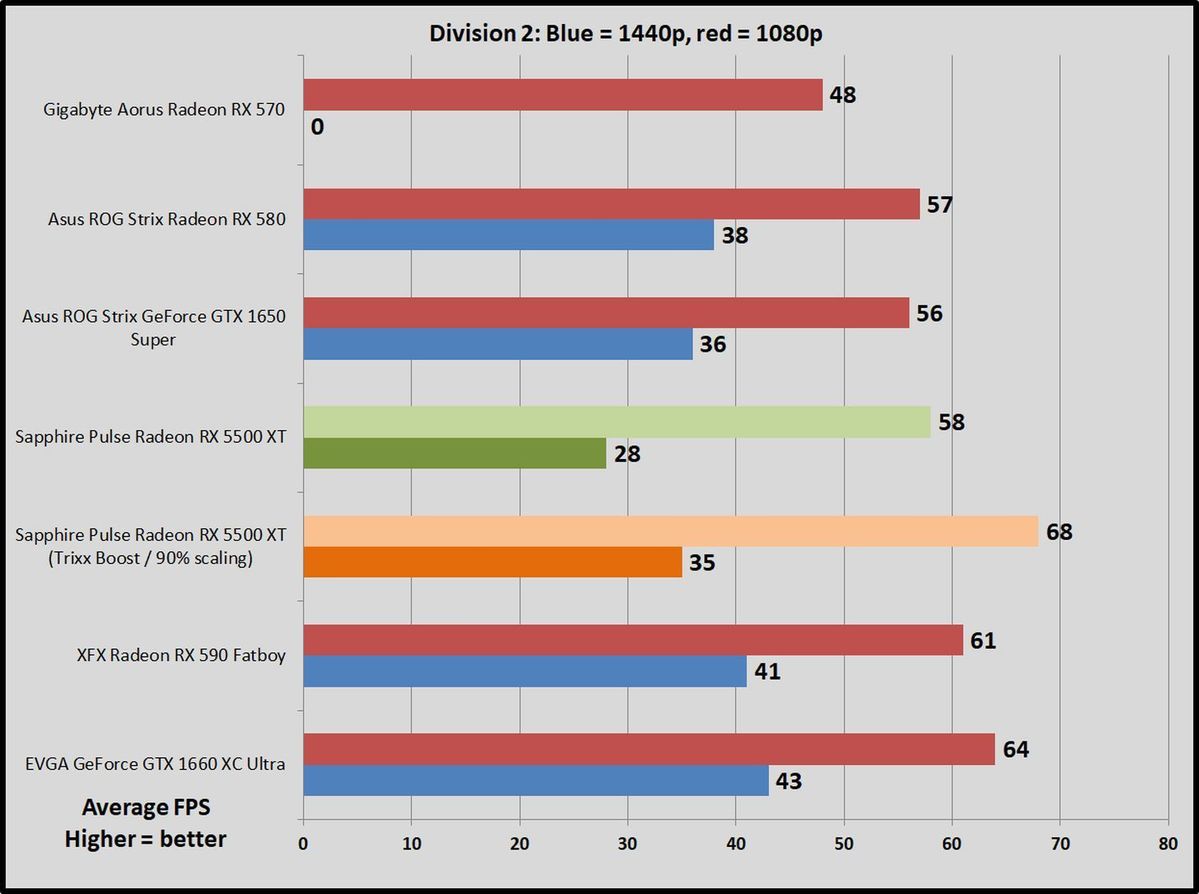 Brad Chacos/IDG
Brad Chacos/IDG The Radeon RX 5500 XT is roughly American Samoa bolted as the GTX 1650 Super, and the older Radeon RX 580—at least at the 1080p resolution the card's intended for. Functioning plummets at 1440p resolution. Sapphire's Trixx Boost technology can motivate the Pulse RX 5500 XT departed even the $200 GTX 1660 with grading set to 90 percent.
Far Cry: New Dawn
Other Ubisoft title, ALIR Cry: New Dawn drags Far Cry 5's wonderful gameplay into a Wiley Post-apocalyptic future of its personal, though this vision is a lot more bombastic—and pink—than The Division 2's bleak setting. The game runs along the latest version of the overnight-running Dunia engine, and it's slightly more straining than Far Cry 5's built-in bench mark.
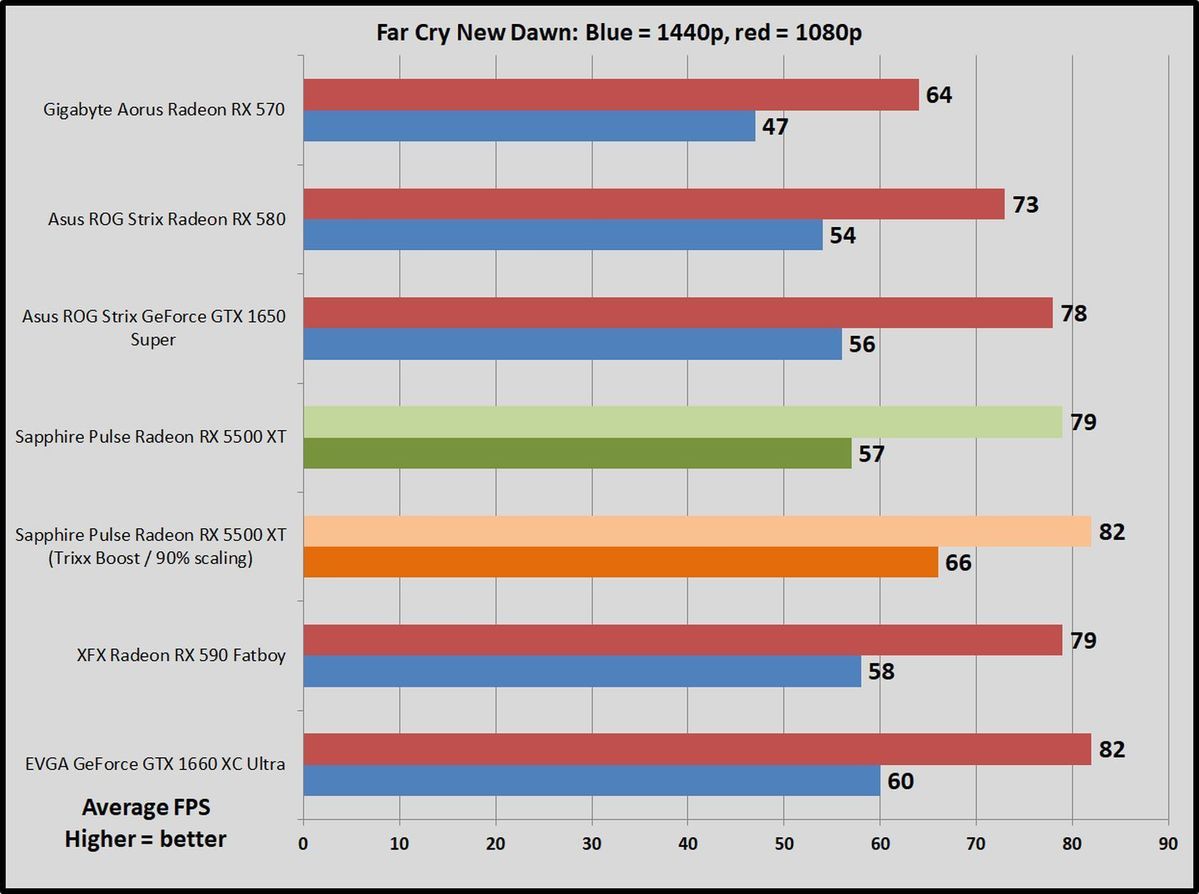 Brad Chacos/IDG
Brad Chacos/IDG AMD's a la mode and superior draws even with the Radeon RX 590 here, rather than the RX 580, and again ties with Nvidia's GeForce GTX 1650 Topnotch. Trixx Boost offers much less benefit at 1080p resolution Hera, though it pushes the game past the sacred 60-FPS standard when activist at 1440p resolution.
Next page: Gaming benchmarks continue
Nonnative Brigade
Strange Brigade ($50 on Baseborn) is a noncompetitive third-person shooter where a team of adventurers blasts done hordes of mythological enemies. It's a technological showcase, built close to the next-gen Vulkan and DirectX 12 technologies and infused with features like HDR brook and the ability to toggle switch unsynchronised compute on and off. It uses Rebellion's custom Azure engine. We test the DX12 renderer with async work out off.
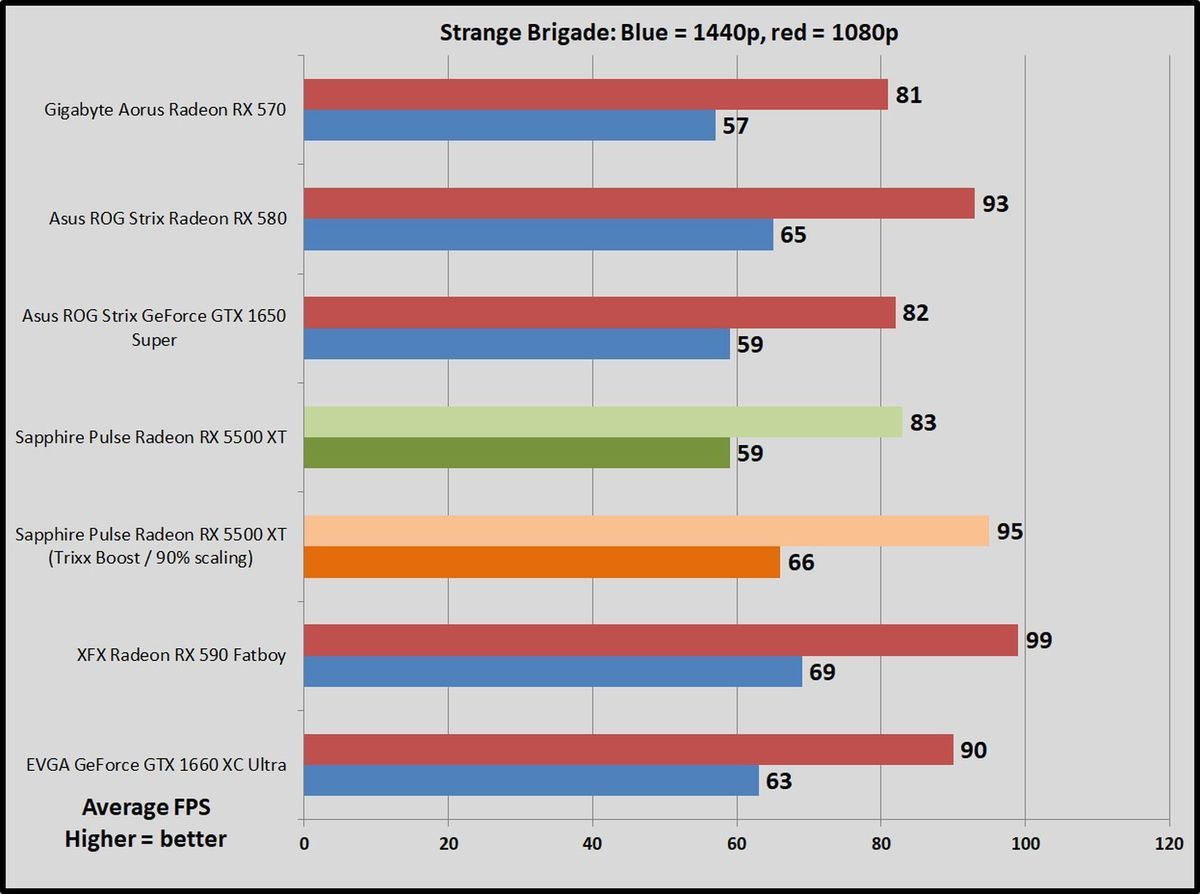 Brad Chacos/IDG
Brad Chacos/IDG Here's an interesting anomaly:Strange Brigade performs often wagerer on all the older Polaris GPUs than the newer Radeon RX 5500 XT and GTX 1650 Comprehensive. The modern models draw fifty-fifty with the Radeon RX 570's carrying into action—a card you can buoy often find on sales event for $120, and sometimes less. The game ostensibly likes larger memory capacities. Either way, Trixx Promote helps the Pulse make up the lost ground.
Shadow of the Tomb Raider
Shadow of the Grave Pillager ($60 on Humble) concludes the reboot trilogy, and it's utterlygorgeous. Square Enix optimized this game for DX12, and recommends DX11 simply if you're using older hardware or Windows 7, so we test with DX12.Shadow of the Tomb Raider uses an enhanced version of the Initiation locomotive engine that also poweredRise of the Tomb Raider.
 Brad Chacos/IDG
Brad Chacos/IDG The Radeon RX 5500 XT is slower than the GTX 1650 Super here, as well as the ancient Radeon RX 580. It's a lot slower than the Radeon RX 590. Over again, Trixx Boost helps the Pulsation correct some of the difference, but it's a discouraging resultant role for AMD's new calling card—especially at 1440p resolution.
Ghost Recon Wildlands
If you crank all the graphics options up to 11, like we manage for these tests,Ghost Recon Wildlands($50 happening Humble) and its AnvilNext 2.0 locomotive utterlymelt GPUs, symmetric with a sequel due later this year. It's by Interahamw the most strenuous game in our suite, even with newer stunners like Division 2 in the commix. Sequel Spook Recon Breakpoint recently launched just has been receiving frequent tweaks, so we haven't swapped over to it for our testing yet.
 Brad Chacos/IDG
Brad Chacos/IDG Ghost Recon's Extremist artwork planned hammers budget art cards. The Radeon RX 5500 XT turns in other dissatisfactory result here, with performance soft between the Radeon RX 570 and RX 580, all these years later. Even with Trixx Hike active, the Pulsation can't keep in the lead with the GeForce GTX 1650 Super.
F1 2018
The latest in a lifelong personal line of credit of successful games,F1 2018($60 on Humble) is a treasure to test, supplying a fanlike array of some graphical and benchmarking options—making it a much more than trustworthy (and amusing) option that theForzaseries. It's built along the quarter version of Codemasters' fatty-smooth Ego biz engine. We exam two laps along the Australia course, with clear skies.
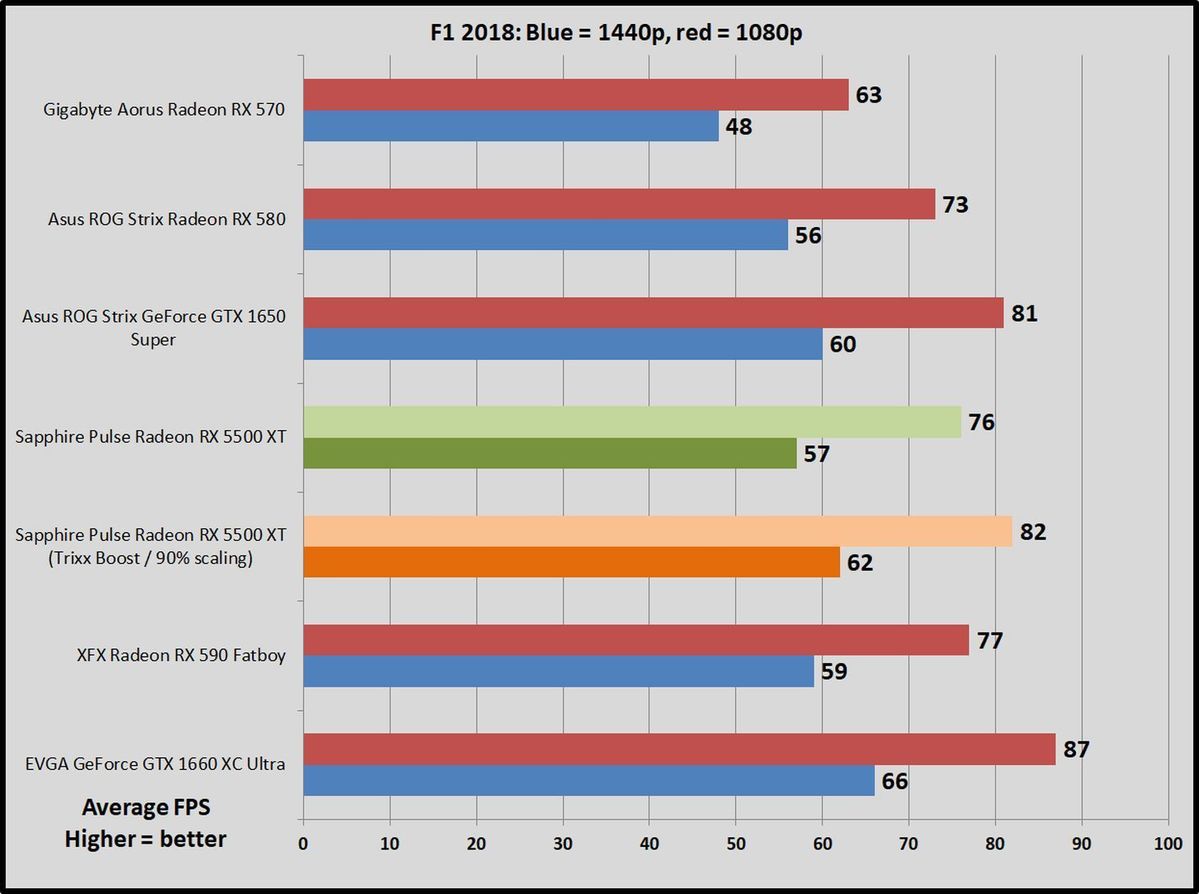 Brad Chacos/IDG
Brad Chacos/IDG The Radeon RX 5500 XT puts in a good showing Here, albeit extraordinary roughly on a par with the Radeon RX 590. The GTX 1650 Ace just puts in a better one.
Next page: Gaming, magnate, and hot benchmarks
GTA V
We're loss to wrap things astir with a game that International Relations and Security Network't really a ocular barn-burner, but still crack the Steam charts day in and Clarence Shepard Day Jr. out. We testNoble Thievery Auto V ($30 along Humble) with all options turned to Real High, all Advanced Graphics options except outspread shadows enabled, and FXAA.GTA Vruns on the Storm engine and has received substantial updates since its initial launch.
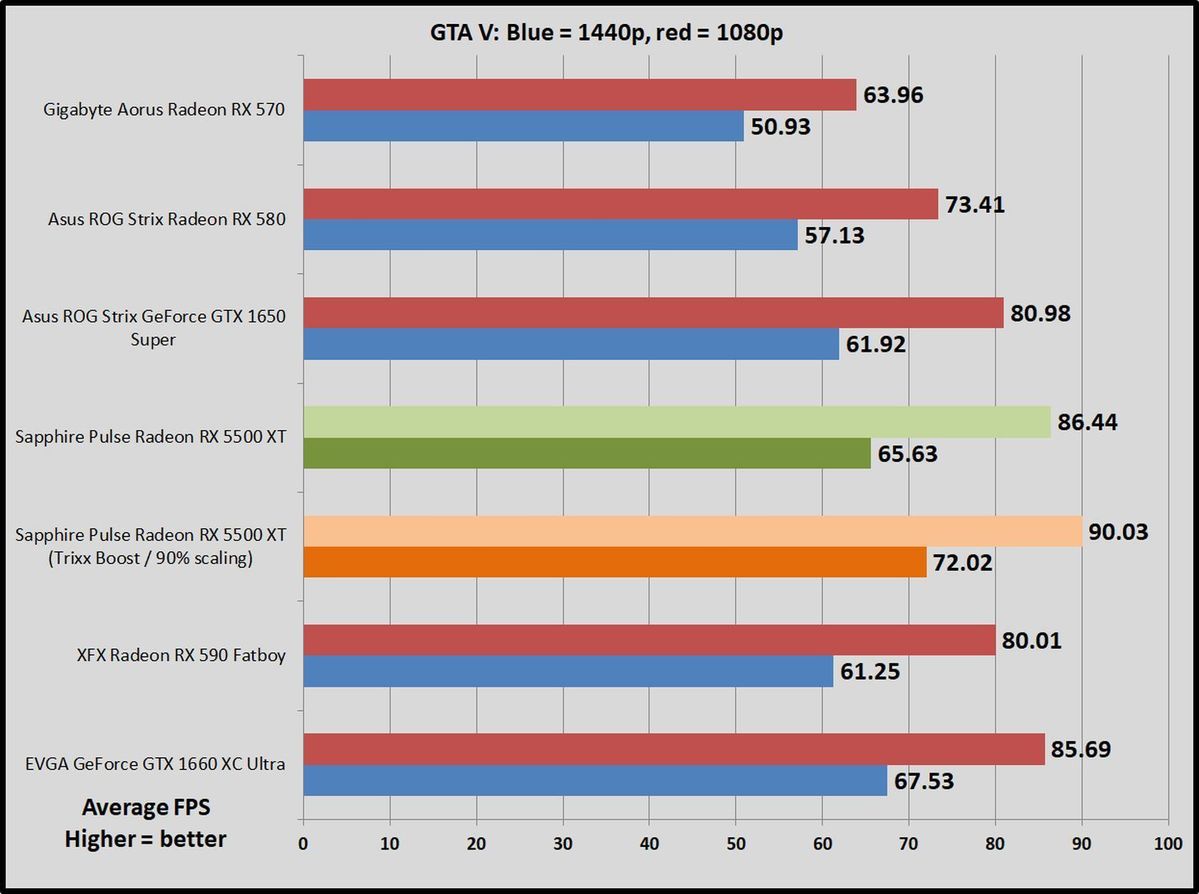 Brad Chacos/IDG
Brad Chacos/IDG While GTA V has traditionally been a big win for Nvidia GPUs, IT loves AMD's new Navi architecture. The Radeon RX 5500 XT shines here, retention pace with the $200 GTX 1660, and olympian it with Sapphire's Trixx Boost active.
World power imbibe, thermals, and resound
We screen power draw by iteration theF1 2018 bench mark for almost 20 transactions after we've benchmarked everything other and noting the highest reading on our Watts Up Pro meter. The first part of the hie, where wholly competing cars are onscreen at the same time, tends to be the most demanding portion. (Note that we did not retest power with Trixx Boost active.)
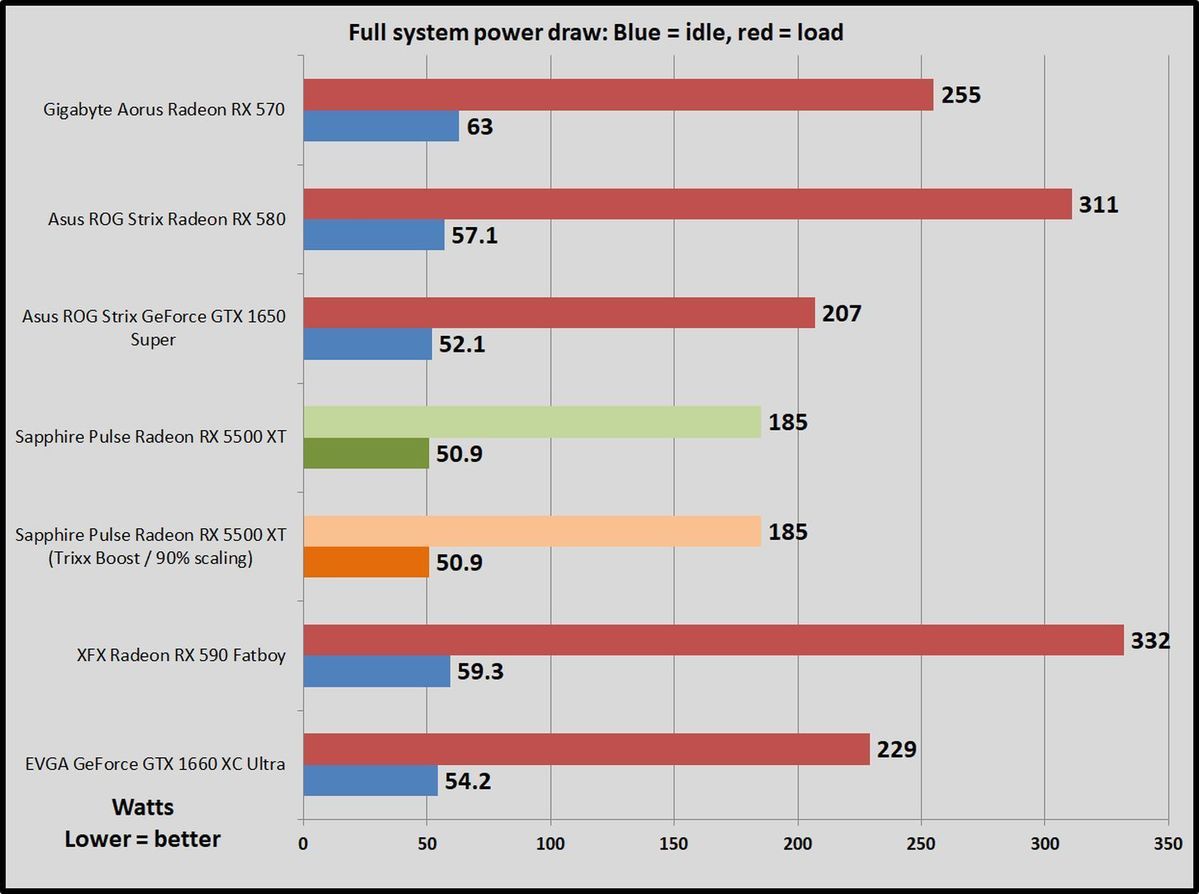 Brad Chacos/IDG
Brad Chacos/IDG AMD's move to 7nm, GDDR6, and the new RDNA architecture cashed off. While Radeon GPUs have been hot and power-hungry compared to their GeForce rivals for several years running, the Radeon RX 5500 XT draws little vigor than the GTX 1650 Super. (It's as wel less powerful, however.)
The rattling question is how the cooler design handles all that baron and the estrus this beastly overclock throws off. The suffice? Exceptionally. We test thermals by leaving GPU-Z open during theF1 2018 Phoebe-lap power draw test, noting the highest maximum temperature at the end. (Note that we did not retest temperatures with Trixx Boost active.)
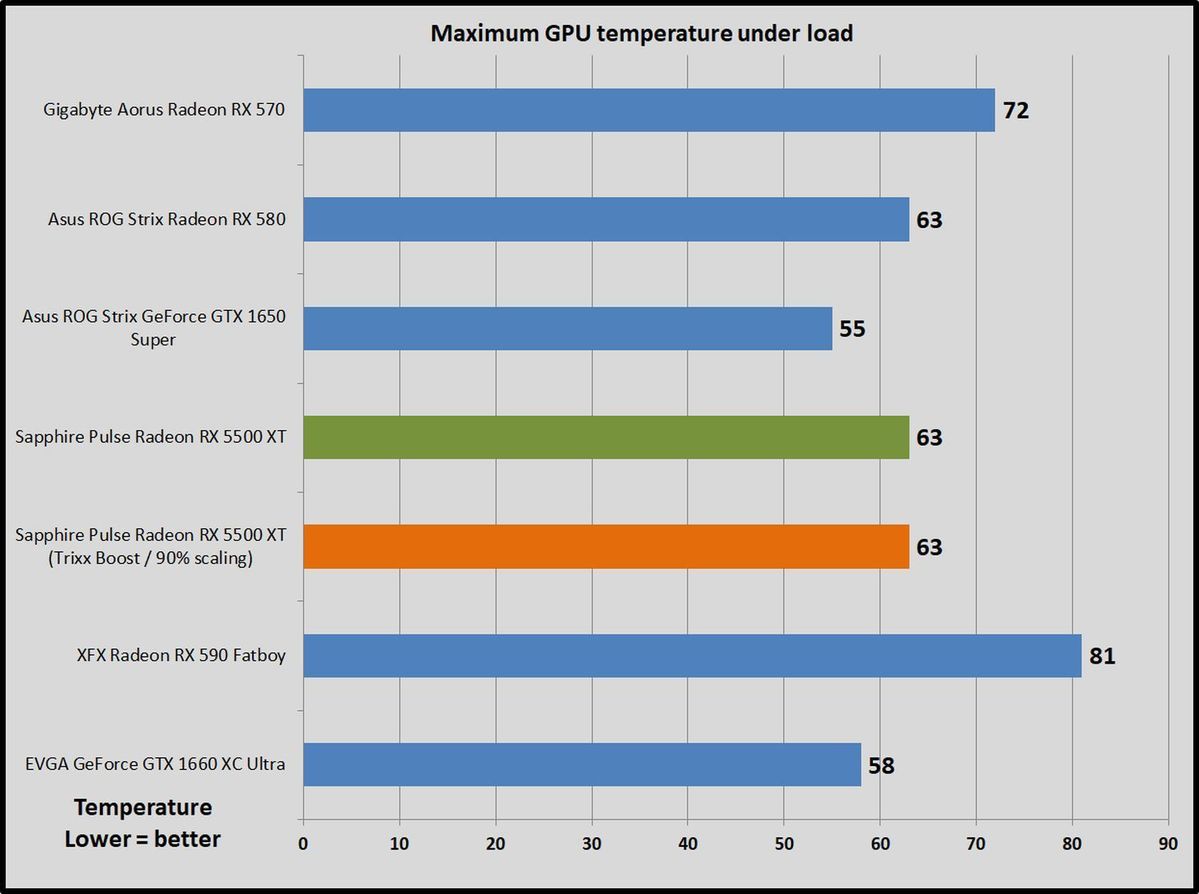 Brad Chacos/IDG
Brad Chacos/IDG Sapphire's Pulse isn't A ludicrously unfriendly as the big ROG Strix tank on the GTX 1650 Super, but don't let that fool you: This is a damned good design. The Sky-blue Pulse Radeon RX 5500 XT stays at 63 degrees Celsius or below, an outstanding upshot for an low-priced cooling solution. Better hitherto, IT's just about silent flush with the default Performance BIOS. Thanks to the out of work rooter stop feature, it's literally inexplicit on the desktop. The Pulse makes AMD's power-effectual GPU even up better with a pure custom cooler.
Next page: Should you steal the AMD Radeon RX 5500 Crosstalk?
Should you buy the AMD Radeon RX 5500 XT?
The Radeon RX 5500 Crosstalk is a sufficient budget 1080p gaming option, but most people would probably be fortunate purchasing Nvidia's GeForce GTX 1650 Super. AMD's cheap circuit board is tranquilize priced as well high against the competition.
Nvidia's GPU is efficaciously equal in performance or flat-out faster than the Radeon RX 5500 XT in most of the games we tested and starts at $10 less. Luxurious customized versions like the Asus ROG Strix GTX 1650 Super we reviewed previously be the same $170 that the Radeon RX 5500 XT uses for service line pricing. GeForce GTX 1650 Super stocks are limited on Newegg, but you'll find single-fan models still available for $160, and several dual-buff versions along Virago.
 Brad Chacos/IDG
Brad Chacos/IDG The Sapphire Pulse Radeon RX 5500 XT.
Moving past Nvidia's options, I can't flatbottom see the Radeon RX 5500 Crosstalk as a clear recommendation over its ancient predecessors. Newegg's merchandising different Radeon RX 580s at or under the RX 5500 XT's $169 opening price, and they all come with free games and 8GB of GDDR5 remembering—double the mental ability of the RX 5500 XT. The Radeon RX 580 equals or even beats the newer card's 1080p performance in many of the games we tested, to a fault, albeit at drastically higher power consumption.
You privy find approximately even faster 8GB Radeon RX 590 models starting at $180 on Newegg. But to the highest degree people should buy a GeForce GTX 1650 Super instead.
AMD's new mainstream GPU has some merit. The Radeon RX 5500 XT delivers satisfying performance for the price at Medium to High graphics presets, best-in-class tycoo efficiency, and a slew of hemorrhage-edge in features that its Polaris-based predecessors want. On the other hand over, PCIe 4.0 capabilities deliver nobelium real-world gambling improvements for nontextual matter cards right now, though AMD's implementation helps improve this poster's power efficiency, and most masses aren't pairing budget GPUs with 4K, 144Hz panels.
 Brad Chacos/IDG
Brad Chacos/IDG Overall value plays a big divide in buying decisions therein Leontyne Price wander. AMD tosses in a free copy of Monster Hunter Ma: Iceborne Master Edition and three free months of Microsoft's excellent Xbox Game Passing for PC, and those goodies could tip the scales sufficiency to sway some masses to Team Red. You could buy out the Radeon RX 5500 XT without disbursement extra on games for at least a quarter of a year. That's powerful, especially if you were already considering picking up MHW.
Definitely consider the Sapphire Pulse if you wish to buy out a Radeon RX 5500 XT. The graphics card comes loaded with some nice extras you don't normally find in affordable custom models—a dual BIOS switch, idle winnow stop, and a metal backplate—and runs very cool and almost imperceptibly pipe down. It's great.
Better yet, the companionship's innovative, thus-far-unrivaled Trixx Boost feature helps push public presentation promote, matching the GTX 1650 Super in rack up-case scenarios and teeing up against the $200 GeForce GTX 1660 in the best. Trixx Boost kicks stern, full stop, though it kicks less ass for the budget Radeon RX 5500 XT than it does in the more potent (and much pricier) Sapphire Nitro+ Radeon RX 5700. The Radeon RX 5500 XT performs best at 1080p resolution, meaning you can't pin into Trixx Boost's downscaling as aggressively atomic number 3 you can with all the pixels shooting forward from the 1440p-focused RX 5700, reducing the potential performance elate. We had to adapt the feature's default 85 percent scaling equal to 90 percent for games to tone good to our eye, though that'll differ for everyone.
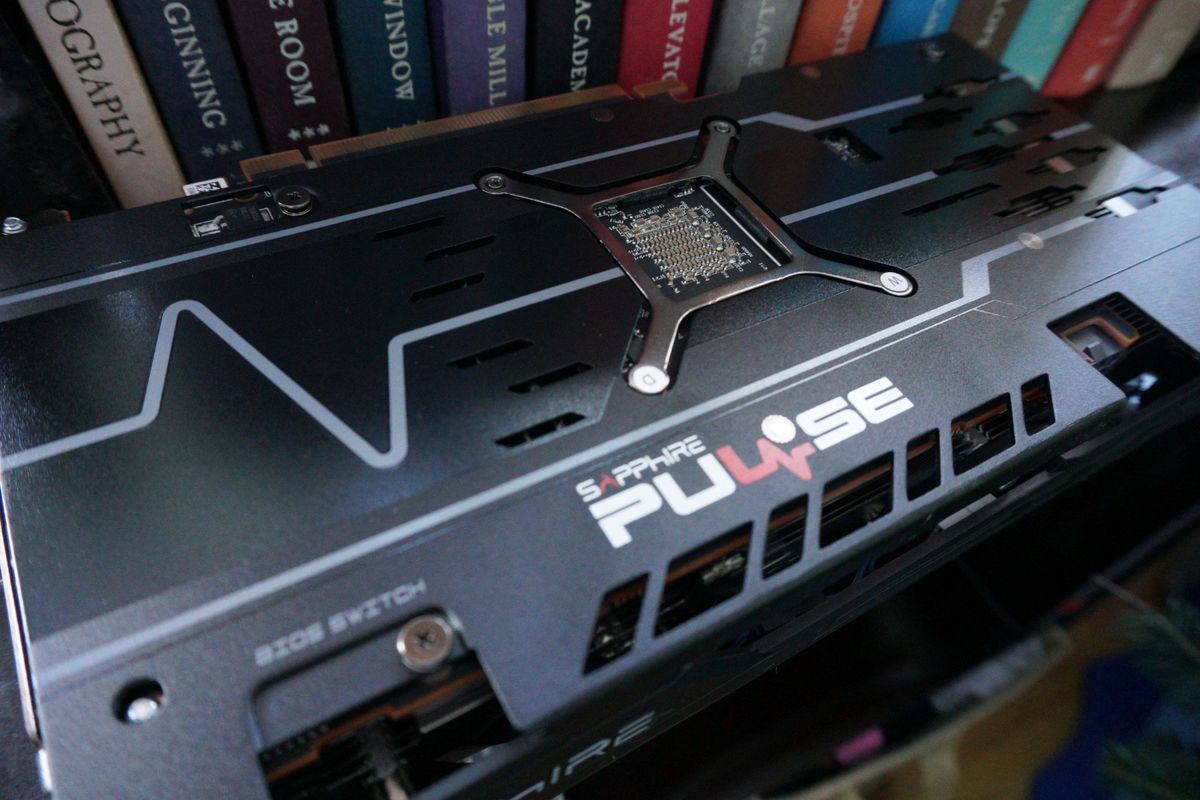 Brad Chacos/IDG
Brad Chacos/IDG Bottom line: The AMD Radeon RX 5500 XT moves the needle forward in damage of features and big businessman efficiency, but non in performance compared to what Pole star-founded Radeon cards give been selling for over the past yr. If the card price $20 surgery $30 little, we'd like it a good deal more in this value-obsessed section of the market. Sapphire's Pulse design and A-one Trixx Boost feature deserve congratulations, nevertheless. If we were reviewing a (non-existent) reference version of the Radeon RX 5500 XT, we'd honor it 3 stars. The extra value provided by Sapphire's customs model relegate it up to a 3.5. The Lazuline Radeon RX 5500 Crosstalk is a eager bespoken cooler design built around a good AMD GPU with a too-high cost.
Riding the bleeding-edge of features ain't cheap, but for budget graphics cards, every dollar matters.
Note: When you purchase something after clicking links in our articles, we may earn a small delegacy. Read our assort connexion insurance policy for more inside information.
Source: https://www.pcworld.com/article/398497/amd-radeon-rx-5500-xt-review-navi.html
Posted by: brownforall.blogspot.com


0 Response to "AMD Radeon RX 5500 XT review: Bleeding-edge on a budget - brownforall"
Post a Comment